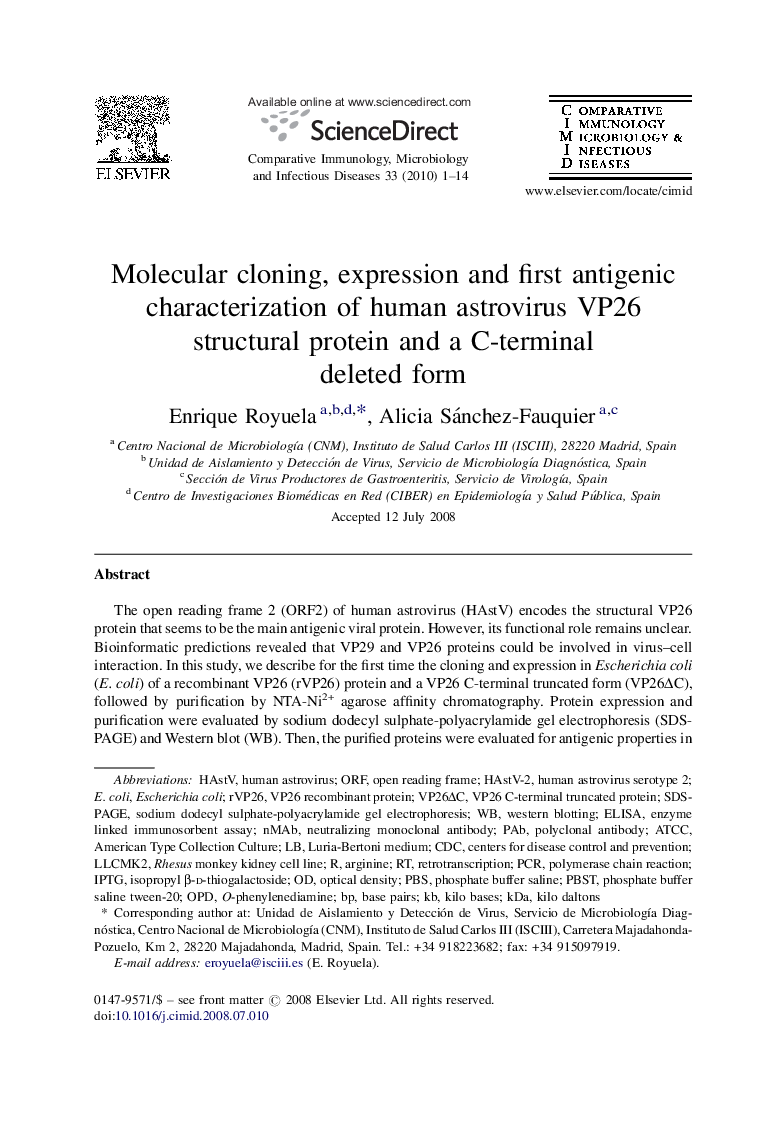| کد مقاله | کد نشریه | سال انتشار | مقاله انگلیسی | نسخه تمام متن |
|---|---|---|---|---|
| 2428433 | 1106314 | 2010 | 14 صفحه PDF | دانلود رایگان |

The open reading frame 2 (ORF2) of human astrovirus (HAstV) encodes the structural VP26 protein that seems to be the main antigenic viral protein. However, its functional role remains unclear. Bioinformatic predictions revealed that VP29 and VP26 proteins could be involved in virus–cell interaction. In this study, we describe for the first time the cloning and expression in Escherichia coli (E. coli) of a recombinant VP26 (rVP26) protein and a VP26 C-terminal truncated form (VP26ΔC), followed by purification by NTA-Ni2+ agarose affinity chromatography. Protein expression and purification were evaluated by sodium dodecyl sulphate-polyacrylamide gel electrophoresis (SDS-PAGE) and Western blot (WB). Then, the purified proteins were evaluated for antigenic properties in enzyme linked immunosorbent assay (ELISA) using a polyclonal antibody (PAb) and a neutralizing monoclonal antibody (nMAb) named PL2, both of them directed to HAstV. The results presented herein indicate that the C-terminal end of the VP26 protein is essential to maintain the neutralizing epitope recognized by nMAb PL2 and that the N-terminus of VP26 protein may contain antigenic lineal-epitopes recognized by PAb. Thus, these recombinant proteins can be ideal tools for further antigenic, biochemical, structural and functional VP26 protein characterization, in order to evaluate its potential role in immunodiagnosis and vaccine studies.
RésuméLe cadre de lecture ouvert (ORF2) de l’astrovirus humain (AstVH) codifie la protéine structurale VP26 qui semble être la principale protéine antigénique virale. Par contre, son rôle fonctionnel n’est pas clair. Les prédictions bioinformatiques montrent que les protéines VP29 et VP26 pourraient être impliquées dans l’interaction virus cellule.Dans cet étude, on décrit pour la première fois le clonage et l’expression à Escherichia coli (E. coli) d’une forme recombinante (rVP26) et d’une autre tronquée (VP26ΔC) de la protéine VP26, suivi de l’épuration par chromatographie d ‘affinité en Ni2+ - NTA agarose. L’ expression des protéines et sa épuration ont été évaluées par SDS-PAGE et Western blot (WB). Après, les propiétés antigéniques des protéines épurées ont été évaluées par ELISA en employant un anticorps polyclonal (PAb) et un autre monoclonal neutralissant (nMAb) appellé PL2, les deux dirigés vers HAstV. Les résultats qu’on présente ici indiquent que le côté C terminal de la protéine VP26 est essentiel pour la maintenance de l’epitope neutralisant reconnue par PAb. Dans le cas du côté N terminal de la même protéine, il pourrait contenir des epitopes linéaires antigéniques reconnus par PAb. Ainsi, ces protéines recombinantes pourraient être des outils idéaux pour d’autres caractérisations antigéniques, biochimiques, structurales et fonctionnelles de la protéine VP2 qui évaluent leur rôle potentiel dans l’immunodiagnostic et les études de vaccins.
Journal: Comparative Immunology, Microbiology and Infectious Diseases - Volume 33, Issue 1, January 2010, Pages 1–14